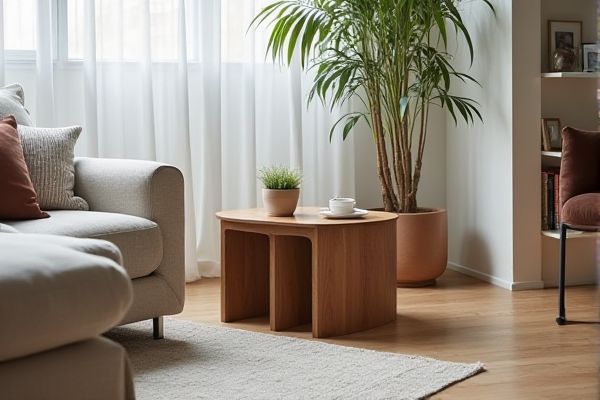
Nesting tables provide versatile stacking options that save space and offer flexible surface areas, while side tables typically serve as standalone pieces suited for specific spots next to furniture. Discover how choosing between nesting and side tables can enhance Your living space by reading the rest of the article.
Table of Comparison
| Aspect | Nesting Tables | Side Tables |
|---|---|---|
| Definition | Embedding one table inside another. | Placing tables adjacent but separate. |
| Use Case | Display related data hierarchically. | Show independent data sets side-by-side. |
| Complexity | Higher complexity; harder to maintain. | Lower complexity; easier maintenance. |
| Performance | Can slow down rendering with deep nesting. | Faster rendering and better responsiveness. |
| Accessibility | May confuse screen readers due to structure. | Better for screen readers; clear structure. |
| Responsiveness | Challenging to make responsive; tables shrink poorly. | Easier to adapt for different screen sizes. |
| Styling | More complicated CSS selectors required. | Simpler CSS targeting each table. |
| Best Practice | Use sparingly for tightly related data. | Prefer for comparing datasets or separated info. |
Understanding Nesting Tables and Side Tables
Nesting tables are a set of smaller tables designed to fit compactly beneath a larger table, maximizing space efficiency and offering flexible surface options. Side tables are standalone pieces placed beside seating areas, providing convenient access to items like lamps, drinks, or books without occupying much floor space. Both types serve functional and decorative roles but differ in versatility and space-saving capabilities.
Key Design Differences
Nesting tables feature a compact design with multiple tables that slide or stack neatly under one another, optimizing space and versatility in smaller rooms. Side tables typically stand alone, offering a single surface for decorative items or essentials, making them ideal for focused functionality beside seating areas. Your choice between nesting and side tables depends on the balance you seek between space-saving modularity and straightforward placement.
Functionality and Versatility Comparison
Nesting tables offer exceptional space-saving functionality by stacking neatly when not in use, making them ideal for compact living areas, while side tables provide a stable, fixed surface placed individually next to seating. Versatility in nesting tables comes from their ability to be separated and used in multiple configurations, supporting various activities and changing needs throughout the day. Side tables excel in versatility through design variety and placement options, often doubling as storage solutions or decorative accents in living spaces.
Space-Saving Benefits
Nesting tables offer superior space-saving benefits by stacking neatly together when not in use, making them ideal for compact living areas. Side tables typically occupy fixed floor space, limiting flexibility in small rooms. Nesting sets provide versatile, multi-functional surfaces without cluttering the area.
Popular Materials and Finishes
Nesting tables often feature versatile materials like solid wood, metal, and tempered glass, with finishes ranging from natural wood tones to sleek matte black or brushed metal that complement modern and traditional decor. Side tables commonly come in materials such as MDF with veneer, marble, and acrylic, offering finishes including glossy lacquer, stone textures, or transparent surfaces that add elegance and functionality. Choose your table based on material durability and finish style to best match your living space's aesthetic and usage needs.
Style and Aesthetic Impact
Nesting tables offer a sleek, space-saving design with a modern aesthetic, seamlessly fitting into contemporary interiors while providing layered visual interest. Side tables often serve as standalone statement pieces, allowing for more elaborate styles and personalized decor opportunities to enhance your room's character. Your choice between the two depends on whether you prioritize versatile functionality or distinctive style impact in your living space.
Ideal Room Placements
Nesting tables are ideal for small living rooms or compact spaces where flexibility and space-saving are crucial, often positioned beside sofas or armchairs for easy access. Side tables work well in larger rooms, placed next to seating areas or beds to hold lamps, drinks, or decorative items without obstructing movement. Both options can complement various room layouts but nesting tables offer the advantage of expandable surfaces without permanently occupying extra floor space.
Pros and Cons of Nesting Tables
Nesting tables offer space-saving versatility as they can be stacked together when not in use, making them ideal for smaller living areas. They provide flexible surfaces for multiple uses, such as serving drinks or displaying decor, but may be less stable and less sturdy compared to solid side tables. You benefit from their compact design and adaptability, though be mindful that frequent sliding or moving can cause scratches on flooring or damage to finishes.
Pros and Cons of Side Tables
Side tables provide convenient surface space next to seating areas, making them ideal for holding drinks, lamps, or decorative items without taking up much room. Their fixed size offers stability but limits flexibility in arrangement compared to nesting tables that can be stacked or separated as needed. Your choice depends on whether you prioritize adaptability or consistent functionality in your living space.
Choosing the Right Table for Your Home
Nesting tables offer versatile space-saving solutions, ideal for small living areas due to their stacked design, allowing easy expansion and compact storage. Side tables provide a stable and often larger surface area, perfect for placing lamps, books, or decorative items beside sofas or beds. Selecting the right table depends on your room size, functional needs, and aesthetic preferences, ensuring both style and practicality in your home.
 homyna.com
homyna.com